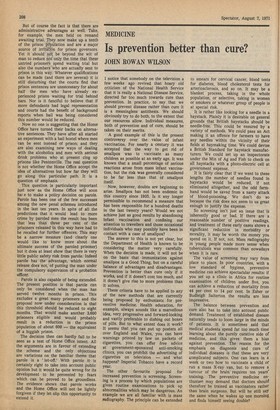MEDICINE
Is prevention better than cure?
JOHN ROWAN WILSON
I notice that somebody on the television a few weeks ago revived that hoary old criticism of the National Health Service that it is really a National Disease Service, directed far too much towards cure than prevention. In practice, to say that we should prevent disease rather than cure it is a meaningless antithesis. We should obviously try to do both, to the extent that our resources allow. Individual measures, both of prevention and of cure, should be taken on their merits.
A good example of this is the present controversy over the value of infant vaccination. For nearly a century it was accepted that the way to get rid of smallpox was to vaccinate as many children as possible at an early age. It was known that a small percentage of serious reactions arose from mass infant vaccination, but the risk was generally considered to be far less than that of smallpox itself.
Now, however, doubts are beginning to arise. Smallpox has not been endemic in this country since 1935. Is it any longer permissible to recommend a measure that has been responsible for a hundred deaths in the last twenty years? Would we not achieve just as good results by abandoning infant vaccination and confining our attention to travellers and those occasional individuals who may possibly have been in contact with a case of smallpox?
The answer to this is not yet clear, but the Department of Health is known to be considering the matter very carefully. When the decision is made, it will not be on the basis that immunization against smallpox is a Good Thing, but on a careful balance of advantages and disadvantages. Prevention is better than cure only if it works, and if it doesn't cost too much, and it doesn't give rise to more problems than it solves.
These criteria have to be applied to any of the new methods that are currently being proposed by enthusiasts for preventive medicine. Health education, for example, always sounds like a marvellous idea, very progressive and forward-looking and vastly preferable to dishing out boxes of pills. But to what extent does it work? It seems that you can put up posters all over England and Wales, you can have warnings printed by law on packets of cigarettes, you can offer free advice at government-sponsored anti-smoking clinics, you can prohibit the advertising of cigarettes on television — and what happens? Imperial Tobacco have a record year.
The other favourite proposal for increased prevention is screening. Screening is a process by which populations are given routine examinations to pick up abnormalities which may be dangerous. An example we are all familiar with is mass radiography. The principle can be extended to smears for cervical cancer, blood tests for diabetes, blood cholesterol tests for arteriosclerosis, and so on. It may be a blanket process, taking in the whole population, or selective, taking in women or smokers or whatever group of people is at special risk.
It is rather like looking for a needle in a haystack. Plainly it is desirable on general grounds that British haystacks should be needle-free. This could be ensured by a variety of methods. We could pass an Act making it an offence for farmers to have any needles within the vicinity of their fields at haymaking time. We could devise a British Standard for haystack manufacturers. We could set up an inspectorate under the Min of Ag and Fish to check on all haystacks with a photo-electric cell at government expense.
It is fairly clear that if we went to these lengths the number of needles found in haystacks would be reduced, if not eliminated altogether, and the odd farmhand would be saved from a nasty attack of blood-poisoning. We don't do so because the risk does not seem to us great enOugh to justify the expense.
So screening isn't just an issue that is inherently good or bad. If there are a reasonable number of positive readings, and treatment of these early cases shows a significant reduction in morbidity or morality, it may be worth the money you spend on it. If not, not. Mass radiography in young people made more sense when tuberculosis was common than nowadays when it is rare.
The value of screening may vary from place to place. In poor countries, with a low standard of hygiene, preventive medicine can achieve spectacular results: if you set up a clinic in Africa for routine examination of children under five, you can achieve a reduction of mortality from 44 per cent to 14 per cent. In Esher or Budleigh Salterton the results are less impressive.
The balance between prevention and cure also has to take into account public demand. Treatment of established disease naturally tends to loom large in the minds of patients. It is sometimes said that medical students spend far too much time learning about the purely curative side of medicine, and this gives them a bias against prevention. The reason for the emphasis on diagnosis and cure of individual diseases is that these are very complicated subjects. One can learn in a week or two how to vaccinate a child or run a mass X-ray van, but to remove a tumour of the brain requires ten years training. The preventive medicine enthusiast may demand that doctors should therefore be trained as vaccinators rather than brain surgeons. But will he still say the same when he wakes up one morning and finds himself seeing double?


































 Previous page
Previous page